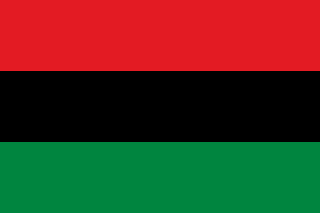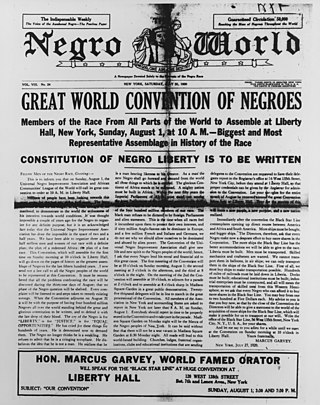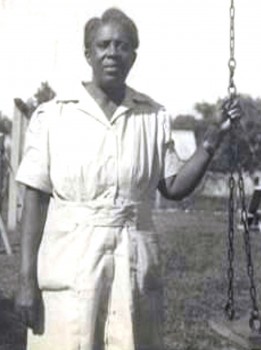
Marcus Mosiah Garvey Jr. was a Jamaican political activist. He was the founder and first President-General of the Universal Negro Improvement Association and African Communities League, through which he declared himself Provisional President of Africa. Ideologically a black nationalist and Pan-Africanist, his ideas came to be known as Garveyism.

The Pan-African flag is a tri-color flag consisting of three equal horizontal bands of red, black, and green. The Universal Negro Improvement Association and African Communities League (UNIA-ACL) formally adopted it on August 13, 1920, in Article 39 of the Declaration of the Rights of the Negro Peoples of the World, during its month-long convention at Madison Square Garden in New York City. Variations of the flag can and have been used in various countries and territories in the Americas to represent Garveyist ideologies.

The Universal Negro Improvement Association and African Communities League (UNIA-ACL) is a black nationalist fraternal organization founded by Marcus Garvey, a Jamaican immigrant to the United States, and Amy Ashwood Garvey. The Pan-African organization enjoyed its greatest strength in the 1920s, and was influential prior to Garvey's deportation to Jamaica in 1927. After that its prestige and influence declined, but it had a strong influence on African-American history and development. The UNIA was said to be "unquestionably, the most influential anticolonial organization in Jamaica prior to 1938," according to Honor Ford-Smith.

Pan-African colours is a term that may refer to two different sets of colours:

Garveyism is an aspect of black nationalism that refers to the economic, racial and political policies of UNIA-ACL founder Marcus Garvey. The ideology of Garveyism centers on the unification and empowerment of African-descended men, women and children under the banner of their collective African descent, and the repatriation of the descendants of enslaved Africans and profits to the African continent.

Negro World was the newspaper of the Marcus Garvey's Universal Negro Improvement Association and African Communities League (UNIA). Founded by Garvey and Amy Ashwood Garvey, the newspaper was published weekly in Harlem, and distributed internationally to the UNIA's chapters in more than forty countries. Distributed weekly, at its peak, the Negro World reached a circulation of 200,000.

Henrietta Vinton Davis was an elocutionist, dramatist, and impersonator. In addition to being "the premier actress of all nineteenth-century black performers on the dramatic stage", Davis was proclaimed by Marcus Garvey to be the "greatest woman of the Negro race today".

Amy Euphemia Jacques Garvey was a Jamaican-born journalist and activist. She was the second wife of Marcus Garvey. She was one of the pioneering female Black journalists and publishers of the 20th century.
Samuel Haynes was a Belizean soldier, activist and poet best known for writing the national anthem of Belize, Land of the Free.
Negro Factories Corporation was one of the business ventures of the Universal Negro Improvement Association and African Communities League recognized by 125 countries worldwide with its own Constitution and flag. The UNIA-ACL is a black nationalist fraternal organization founded in 1919 by Marcus Garvey, a North American Jamaican-born activist in New York. It eventually had chapters on three continents and in the Caribbean.
The Rastafari movement in the United States echoes the Rastafari religious movement, which began in Jamaica and Ethiopia during the 1930s. Marcus Garvey, born in Jamaica, was influenced by the Ethiopian king Haile Selassie. Jamaican Rastafaris began emigrating to the United States in the 1960s and 1970s, and established communities throughout the country.
Amy Ashwood Garvey was a Jamaican Pan-Africanist activist. She was a director of the Black Star Line Steamship Corporation, and along with her former husband Marcus Garvey she founded the Negro World newspaper.

Emory J. Tolbert (1946-2022) was an American historian, educator, and activist. His scholarship centers on Marcus Garvey and Garveyism, as well as wider aspects of African American history.

Cleopatra White was a Belizean nurse, social worker and community leader. She was the second matron of the Black Cross Nurses Association. She was one of the first formally trained nurses in Belize and was the first rural health practitioner in Gales Point and the Manatee River area of Belize. She also organized the first village council in the country, in Gales Point, recognizing the need for managing village affairs, especially in the case of hurricanes. Her model was replicated throughout Belize, and she is credited with the idea for the present village council system. She served in the relief efforts of the 1931 hurricane, Hurricane Janet (1955) and Hurricane Hattie (1961). She received a Victoria Medal in 1953 for her services from the British crown and, in 1958 went to England to accept the British Empire Medal.
Vivian Wilhelmina Myvett Seay (1881–1971) was a British Honduran nurse, social reformer and activist. Seay, Creole and of the middle class, attended the Anglican Church school and earned her teaching credentials in the pupil-teacher program. In 1920, she founded the country's Black Cross Nurses and led the group until she died, 51 years later. A social activist, the legalization of divorce in Belize is partially attributed to her work. In 1951, she was the only woman founder of the National Party and she was the country's second woman citizen to be honored as Member of the Order of the British Empire.

Maymie de Mena was an American-born activist who became one of the highest-ranking officers in the Universal Negro Improvement Association (UNIA). She has been credited with keeping the organization alive after Marcus Garvey's conviction for mail fraud and deportation from the United States.
Henry Vinton Plummer, Jr. was an American lawyer, real estate agent, civil rights activist, and black nationalist. In the 1920s he became involved in Marcus Garvey's Universal Negro Improvement Association and African Communities League (UNIA), leading the organizations publicity and propaganda wings, Garvey's secret service, and its militia.
Mason Alexander Hargrave was an organizer in the African-American community. He spent his later years in Cleveland, Ohio, in a leadership role at the United Negro Improvement Association (UNIA). He was involved in promoting use of the red, black, and green Pan-African flag and had it flown over Cleveland City Hall in 1974. He was an acolyte of Marcus Garvey and wrote a letter of "testimony" to U.S. Representative John Conyers in 1987 objecting to mail fraud charges against Garvey.
Harold Herbert Potter was the first Canadian-born Black sociologist hired by a Canadian post-secondary institution when he was appointed lecturer in Sociology at Sir George Williams College in 1947.
Dara Abubakari was an activist and advocate for Pan-African organizing and black nation-building. She was an important member of a number of organizations, including the Universal Negro Improvement Association, the Communist Party, and the Universal Association of Ethiopian Women. In later decades, she emerged as a key leader in groups such as the Republic of New Africa and the Revolutionary Action Movement. Through her guidance, these organizations helped inspire and influence the next generation of activists with their Pan-African political vision and dedication to activism.










